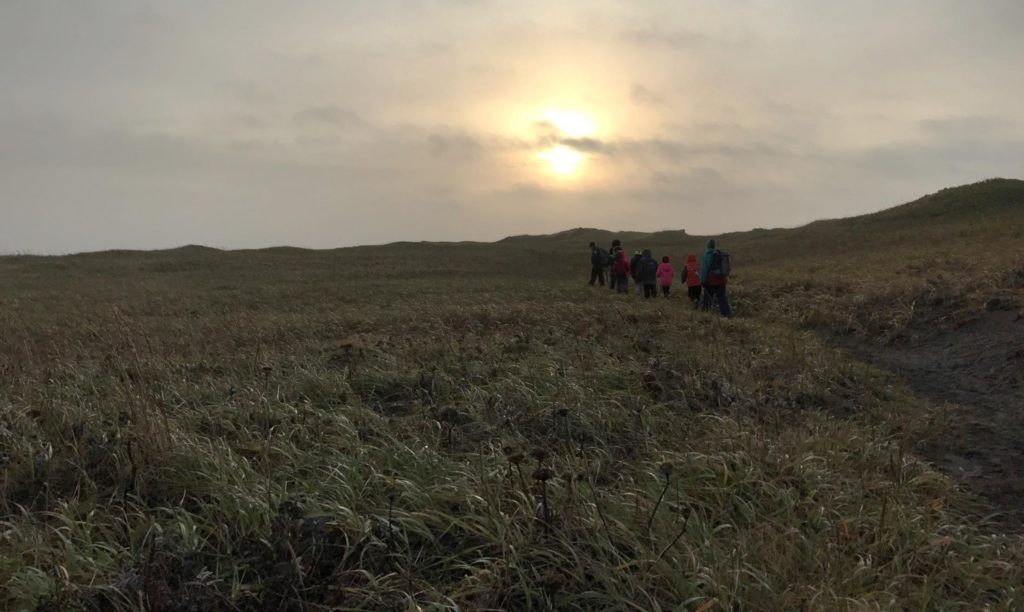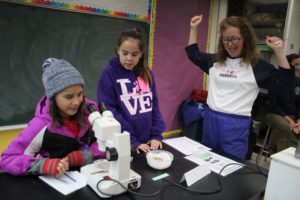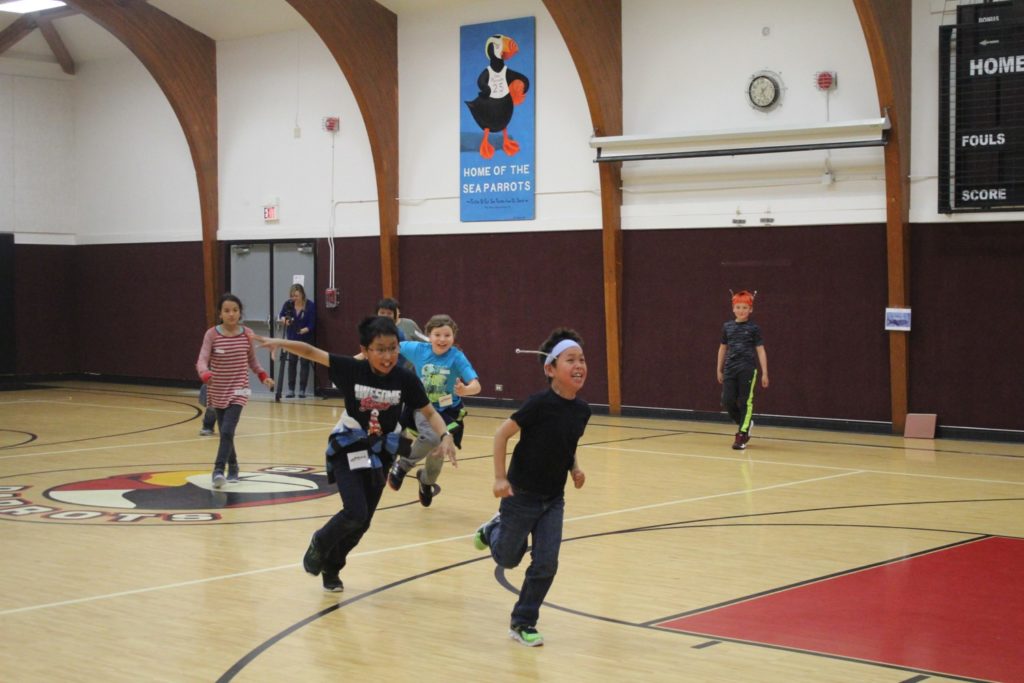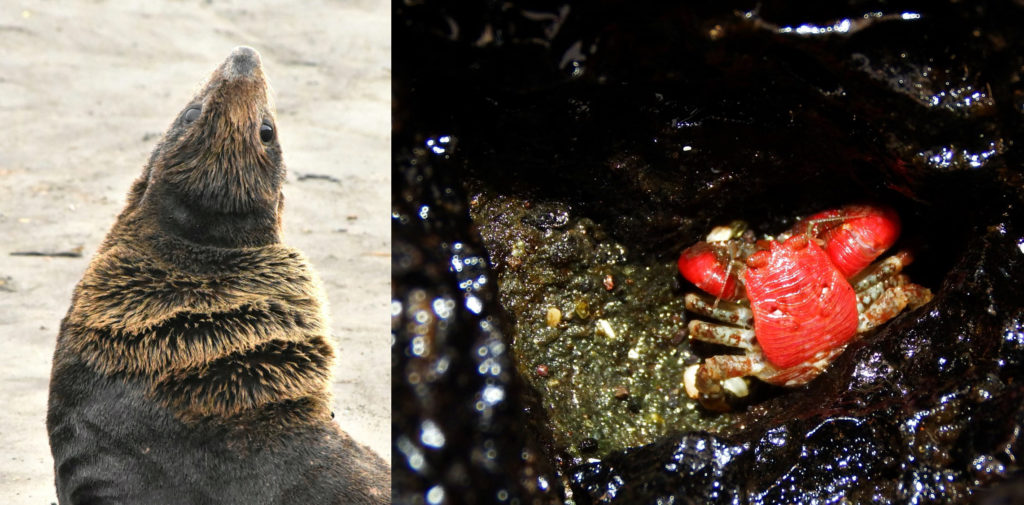by Linda McCann, SERC biologist
The teachers on Alaska’s Pribilof Islands have a tradition. Every year for the last decade, they have invited scientists, educators and innovators from across the U.S. to take over their school for a week. The festival is known as Bering Sea Days. This year, marine biologist Linda McCann of the Smithsonian Environmental Research Center joined a team of 22 scientists and educators, leading games and activities to teach the community about the research being done on the unique animals and environment of the Bering Sea. Read the first-hand narrative below for a glimpse inside this remote Alaskan community.

Students and educators hike through the rugged landscape of Alaska’s St. Paul Island. (Credit: Linda McCann)

Students on St. Paul Island look at bryozoans through a microscope, with biologist Linda McCann. (Credit: Veronica Padula)
Flying into the Pribilof Islands of Alaska, you cannot help but be mesmerized by the beauty of the landscape of the far north – the craggy mountain peaks, the glaciers, the vast expanse of open ocean, as you near this tiny little speck of rock in the Bering Sea. The islands are home to the Aleut or Unangan people. Of the four volcanic islands, only two are inhabited. This weekend, at least 20 scientists and educators will descend on the approximately 500 souls living on St. Paul, an island roughly 12 miles across, to teach them about the science going on in the Bering Sea. We will spend a week in the only school on the islands, immersing students ages 4 to 18 years old in every aspect of science: We’ll play games about fur seals and puffins, dissect king crabs, learn about food chains, and simulate meetings of countries on the Arctic circle. We’ll eat fish pie with the community and talk about what’s most important to them. This is Bering Sea Days!
Initiation
We meet at Trident, the fish processing plant. The food is cafeteria style, and it’s good – fresh fish, vegetables, potatoes and all the fixings. The fish is halibut, and it takes up the length of a pan at least 2 feet long. It’s the biggest fish I’ve ever seen! After dinner, all of us are herded onto a small tour bus parked out front. The driver proceeds to tell us about the “gremlins” in the bus. “The breaks don’t work, so chock the wheels so you don’t lose anyone,” he says. (If you don’t know what chocking is, it means to put a heavy block in front of the front tires). By this time, we figure out that we are being instructed how to drive the bus! When someone asks what safety regulations we should follow when transporting kids around the island, here’s the general drift of what we are told:
“There are no rules! The van has many gremlins. Let the bus warm up for 15 minutes if you want it to go more than 10 miles per hour. After it’s warm, it will immediately take you to 50 miles per hour if you are not careful. And this fan: Possessed!” The directions and explanations go on for several more minutes, and then we file off the bus. I, for one, am determined to do everything in my power to avoid using this bus. Walking is good for your health, after all.
A Day on St. Paul Island

In an invasive species game, students pretend to be invasive green crabs (with head bands) sharks or ocean currents. (Credit: Veronica Padula)
Rise at 6:30, breakfast at the fish processing plant, at school by 8am, still dark. Set up the gym to prepare for the Invasions Game with the 4th and 5th grade class of about 17 kids. I talk to them about the concept of invasive species and the non-native European green crab that is poised to enter Alaskan waters on the British Columbia border. The object of the game, if you are a crab, is to get to St. Paul and invade. The object of the game, if you are an ocean current or a predator, is to stop the crabs from reaching the island. We distribute the swag to identify the roles. The kids seem eager and enthusiastic to run, and especially to be crabs, who get headbands with antennae on them which bobble as they run. The game goes well, and it’s on to my next class. I help with a grade 2-3 class on food webs.
The day is action packed, with activities, field trips and presentations. We are leading lessons or assisting most of each day. The kids learn about fur seal physiology, marine seabird censusing, archaeology, king crabs, food webs, marine and terrestrial invasives and the list goes on! It’s all fascinating, and I want to be a student there and attend every class!
After dinner at Trident, I walk to the edge of the rocks and watch the sea pound the beach. The winds are increasing and occasionally the waves crash over the top of the rock wall, which I imagine is at least 20 feet tall. Several of us go to a craft studio to make bracelets from moose hide. Not something I’d ever envisioned doing as long as I lived, but it’s great fun and allows me to get to know more of the other presenters. There is so much enthusiasm and creativity streaming out of the hands of the Bering Sea Days scientists. It’s amazing to see what they make. It’s nearly 9:30 at night and there is still a bit of twilight outside. Despite it being October, I am reminded that I am near the land of the midnight sun. There is still some faint, diffuse light when I close my eyes to sleep later that night.
Over the course of the week, I teach every age group in the school of 45 kids and learn who many of them are by name. I walk the town and am blown sideways by the wind. I stuff myself with salmon and halibut from local waters. I watch the fur seals play in the surf (from a distance) and fall in love with them. I watch the sea and feel its immense power here.

Alaskan wildlife. Left: Fur seal. Right: Wrinkled crab, Dermaturus mandtii. (Credit: Linda Shaw)
Last Day
The final day rushes past like a stream of consciousness: Usual rising in the dark, throw my clothes in my suitcase and fly out the door to breakfast. Team up with Missy and Mike, two other visiting researchers for a traveling museum piece on kelp forests, show the Smithsonian film “Ecosystems on the Edge” on the invasive barnacle parasite that turns mud crabs into zombies, lead a discussion about exhibit making, museums and related jobs, improvising in the classroom and it all works! Kids build the exhibit, try to connect to the internet to send pictures to the Smithsonian but no luck, I run all the way back to staff quarters, finish packing in 10 minutes, trip to north end with birders—sun’s out, brilliant landscapes, fur seals peeking over the top of the cliff edge at us—early airport check in, hitchhike back to town, clean the room and forage for lunch, back to the airport for 3:45PM flight. Airline announces no luggage can go on the flight because of fuel weight, 10 minutes later all luggage can go on the flight, chatting with tribal council rep from St. George Island, board plane at 4:45, 9 rows, 27 seats, earplugs handed out and necessary. Touch down to deliver Bering Sea Days swag to kids on St. George Island who missed out on the fun in St. Paul (there are only 4 students in the community of approximately 100 people there!), and a birthday cake for a child on St. George. Pick up five passengers. The sky is misty and overcast. Snowy peaks on the mainland, sunset from the air, and then we are in Anchorage. Was I really in the Bering Sea for a week or did I dream it all?

